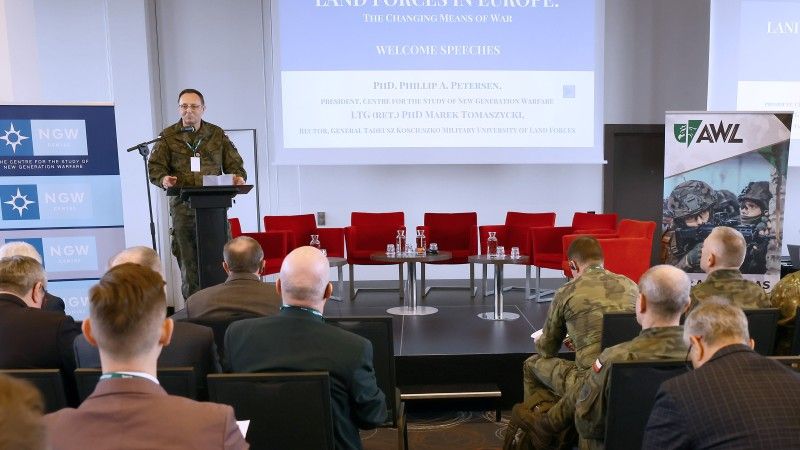Ukraine as a Compass for the Future: How the Battlefield is Changing?

Photo. Marek Kańtoch / AWL
Deterrence must be credible and influence the adversary’s perception of reality. It is essential to build an advantage, for the military to prepare for difficult scenarios, and to be ready for the rapid implementation of new technologies and solutions. These were some of the conclusions of the conference „Land Forces in Europe: The Changing Means of War,” jointly organized by the Centre for the Study of New Generation Warfare and the Land Forces Academy. The media partner of the event was Defence24.pl.
Conference Details
The event took place on February 20 in Warsaw, at the Grand Mercure Hotel. The conference was attended by high-ranking current and former officers of the Armed Forces of Poland, the Czech Republic, Romania, the United States, and Ukraine, as well as researchers from the Land Forces Academy and representatives of the defense industry. Defence24.pl was the media partner of the event.
The conference was officially opened by Lt. Gen. (Ret.) Marek Tomaszycki, Rector of the Land Forces Academy, and Prof. Phillip A. Petersen, President of the Centre for the Study of New Generation Warfare. The event was held under the Chatham House Rule.
Key Themes of the Conference
The discussions were divided into several panels, focusing on the most critical thematic areas, along with presentations. Initially, representatives of the highest command structures and general staffs debated the strategic aspects of ensuring security in Europe in light of Russia’s aggression. The effectiveness of deterrence largely depends on how the adversary perceives it and whether it prevents them from launching aggression. It was emphasized that while gaining an advantage over the aggressor is crucial, especially in the air domain, soldiers and commanders must also be prepared to operate under unfavorable conditions without a clear advantage, particularly in the initial phase of a potential conflict.
While land operations remain decisive in Eastern Europe, multi-domain operations are essential to impose one’s operational approach on the adversary. Furthermore, communication and information-sharing systems must be integrated even in peacetime, including addressing technical and legal barriers. The entire state, including its population and critical infrastructure, must be prepared for war, as complete protection against attacks is impossible, making infrastructure resilience and reconstruction capabilities critical.
Changes in the Battlefield Environment
Subsequent panels and presentations addressed changes in the battlefield environment since the onset of the full-scale war in Ukraine, as well as myths associated with modern warfare. Discussions also covered maneuver warfare, land forces aviation operations, and fire and engineering support.
It was highlighted that drones are transforming the battlefield, necessitating greater countermeasures from NATO countries, but they are not a universal solution. Tanks, armored fighting vehicles, and helicopters remain essential on the battlefield and must be adapted to evolving threats, particularly through countermeasures against drone threats. Modernization programs in the United States aim to enhance resilience to enemy drones and enable collaboration with friendly unmanned systems through Manned-Unmanned Teaming (MUM-T).
Despite pledges to increase artillery ammunition production, Western countries are still producing too little. Maneuver operations are also becoming more challenging due to the proliferation of precision strike systems, requiring some redefinition of operational principles, though they will remain crucial to military success.
Adaptation and Innovation
A key point emphasized was the importance of rapid adaptation—both in integrating technological innovations from the defense industry and in adjusting battlefield tactics to evolving threats. The enemy is also adapting quickly, particularly in the areas of electronic warfare and tactical adjustments.
A notable observation was that many innovations originate from the lower levels of military units, developed by soldiers in the field, and that these should be widely adopted and supported. However, this requires both cultural and regulatory changes within military structures.
Lessons from the Cold War
During the conference, it was suggested that during the Cold War, NATO armed forces were better trained on a large scale, particularly in engineering support and obstacle breaching. It was argued that these capabilities should be revived, similar to the resurgence of artillery capabilities.
A key challenge is the training of officers and non-commissioned officers for new force structures and modern equipment. The Artillery and Armament Training Center in Toruń plays a crucial role in training personnel based on lessons from Ukraine.
There was also a discussion about removing legal restrictions on cluster munitions production. Although Poland and Romania have not signed the ban on cluster munitions, global restrictions impact their ability to produce them. While cluster munitions leave unexploded ordnance, posing a hazard, they remain an effective fire support tool, even against electronic warfare threats.
Conclusion
The conference concluded with an emphasis on the importance of realistic training and giving adversary simulation forces the freedom to act at multiple levels, from platoon and company engagements to large-scale multi-corps operations. Information-sharing between allies and within armed forces was also deemed essential.
Participants agreed that effective deterrence and defense require the full engagement of state resources and society, with the military being just one component of a broader national defense strategy.



